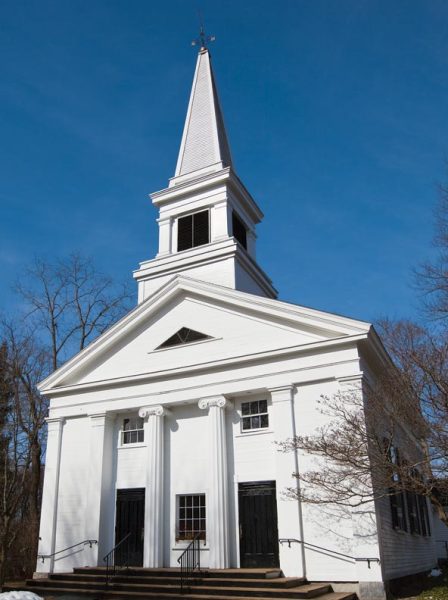
First Parish church dates to the 1840s. (Photo: David Elmes)
My daughter recently asked me, “Who’d want to tour our town?” To a 14-year-old, Lincoln, Massachusetts—12 miles northwest of downtown Boston—might seem rather sleepy. There are only three restaurants, and the nearest hotel accommodations are in neighboring Concord and Lexington (towns that draw plenty of tourists).
But Lincoln is a perfect destination for an architectural history buff, revealing its entire development history through buildings that are visible, preserved, and in many cases open to the public. Don’t make the mistake of thinking that Lincoln is just a leafy bedroom community—there is much history to discover in this small town of 15 square miles.
Revolutionary Roots
Most people know Lexington and Concord as the sites of the first battles of the American Revolution. But few realize that Lincoln, which lies between those two iconic towns, was the epicenter of bloody fighting along what is now Route 2A, dubbed the Battle Road. In fact, on the night of April 18, 1775, Paul Revere did not finish his historic ride to Concord—he was arrested by the British in Lincoln!
Minuteman National Historic Park, which preserves and commemorates the beginning of the American Revolution, has its main visitor’s center in Lincoln. You can stroll along the Battle Road, tour original houses that remain from the time of the battles, visit the Revere capture site, and enjoy the historic landscape of fields and stone walls, which the National Park has worked hard to restore. Privately owned homes nearby date from the late 1600s through the 1700s.
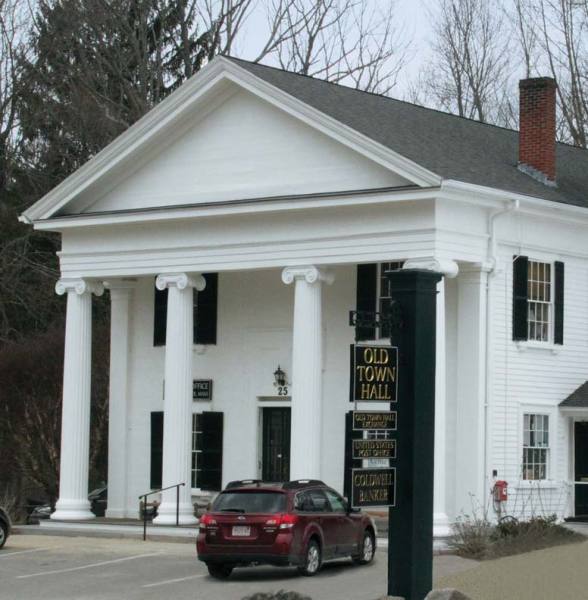
The Old Town Hall is such a classic Greek Revival that Henry Ford wanted to move it to Greenfield Village. (Photo: Jim Cunningham)
Crossing Route 2 leads you into the heart of Lincoln, an idyllically preserved New England town center. The cemetery on Bedford Road holds the remains of British soldiers killed along the Battle Road. The town center also has excellent examples of Federal- and Greek Revival-era buildings, including the 1840s white-steepled First Parish in Lincoln and the Old Town Hall, built in 1848. The latter building almost disappeared in 1928, when Henry Ford came to town, intending to purchase historic buildings to move to Greenfield Village, his new outdoor museum in Dearborn, Michigan. He approached the Old Town Hall’s owner, Charles Sumner Smith, who declined to sell, famously responding, “If it’s good enough for Michigan, it’s good enough for Lincoln.”
The Estate Era
By the turn of the 20th century, wealthy Boston Brahmin families discovered Lincoln’s convenient location and beauty, and began building country estates in the town. Many large manor houses from the estate era are preserved and used today as museums, schools, and nonprofit headquarters. All are worth visiting; they are arranged here by time period.
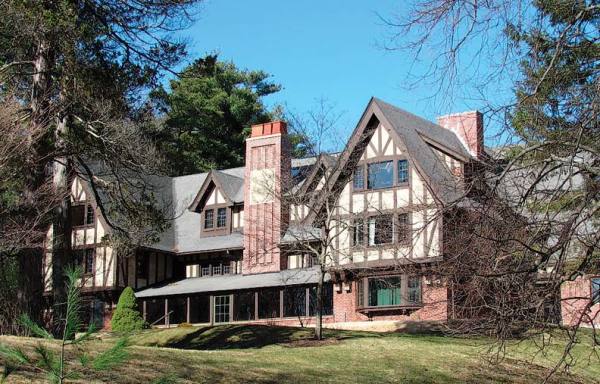
The impressive 1906 Tudor Higginson Estate now houses the Thoreau Society. (Photo: John Phelan)
Helen Osborne Storrow was one of Boston’s most generous philanthropists, and in 1904-05, she built her large brick Arts & Crafts style estate in Lincoln. Storrow helped start Girl Scouts in America and the Saturday Evening Girls Pottery, which made some of the finest ceramics of the Arts & Crafts movement. You can still see the large terrace that she built to stage Morris dances, part of the Arts & Crafts movement’s celebration of folk arts. The Storrow Estate is now the Carroll School, located on Baker Bridge Road, and not generally open to the public—but you can see its impressive carriage house as you pass.
Alexander Henry Higginson was the son of Boston Symphony Orchestra founder Henry Higginson, who bought Alexander land in Lincoln to fulfill his interest in fox hunting and steeplechase. The younger Higginson built an imposing Tudor-style estate on Baker Farm Road in 1906. Today the Higginson Estate houses the Thoreau Society. You can stroll the grounds to enjoy this English-style manor, or enter to research Henry David Thoreau and his connections to Lincoln. (The philosopher first sought to build the cabin he chronicles in Walden on Flint’s Pond; rebuffed by the owner, he retreated to Walden Pond, a couple miles away.)
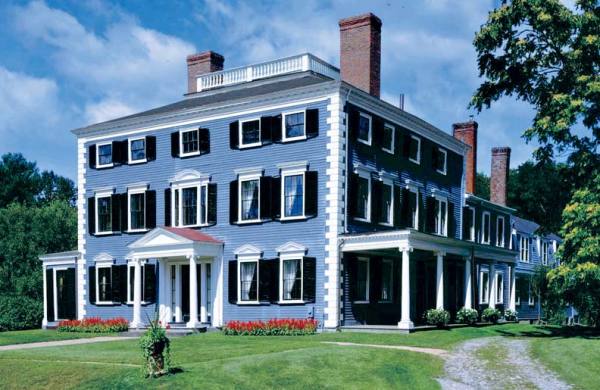
The refined Codman Estate. (Photo: Courtesy of Historic New England)
Anyone interested in period furnishings and design should tour Historic New England’s Codman Estate on Codman Road. Originally built in 1740 by the Codman family, the estate is exquisitely preserved in its Victorian-era incarnation. The interior is the work of Ogden Codman, Jr., co-author of the 1898 book The Decoration of Houses with Edith Wharton.
Julian DeCordova’s turn-of-the-20th-century home on Sandy Pond Road, which he modeled after a European castle, was left to the town of Lincoln upon his death in 1945 to be preserved as a house museum on par with Isabella Stewart Gardner’s residence in Boston. Unfortunately, DeCordova’s collection was deemed less than museum-worthy. The objects were sold, and the home became the DeCordova Museum and Sculpture Park, with a focus on contemporary art.
Mecca for Modernism
Not all is old-timey in Lincoln. In 1937, Helen Osborne Storrow donated some land from her estate to help a newly arrived German immigrant build a house. He was Bauhaus founder Walter Gropius, who had escaped Nazi Germany and moved to Lincoln to head the Harvard University Graduate School of Architecture. In 1938, he built a severe white cube of a house on the land, which immediately became the talk of Lincoln and beyond. Fellow Bauhaus architect Marcel Breuer soon arrived, and built a flat-roofed modern home across the street.
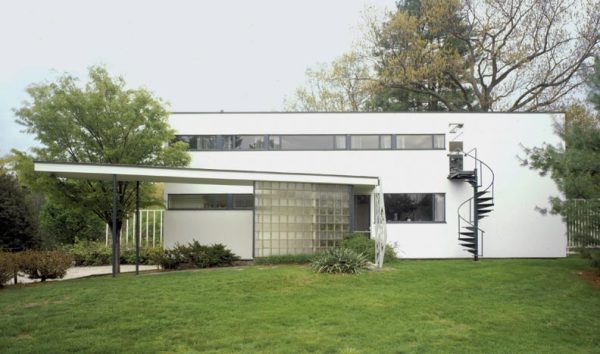
Built in 1937, Gropius House soon became an international icon. (Photo: Historic New England)
Today, Gropius’ house on Baker Bridge Road is operated as a museum by Historic New England and contains the family’s personal furniture and belongings. Walk through the abutting Woods End neighborhood to see a fine collection of early modern homes by architects like Breuer, Gropius, and Walter Bogner, which are privately owned and wonderfully preserved. A driving tour on Tabor Hill Road also will reveal several examples of fine mid-century modern architecture by Henry Hoover, a Lincoln-based architect who actually built the first modernist home in Lincoln one year ahead of Gropius.
Lincoln’s embrace of modernism continues in the Brown’s Wood neighborhood (Laurel Drive and Moccasin Hill). In the early 1960s, a group of MIT professors and their families decided to build their own modernist neighborhood. This tight-knit collective continues to thrive, and periodic tours of it are given by Historic New England and Lincoln’s own Friends of Modern Architecture (FoMA).
To answer my daughter’s question, I do think touring Lincoln is worthwhile—particularly for someone who enjoys history and fine residential architecture. Lincoln’s houses and buildings document a New England town’s journey through the centuries of American history, and demonstrate that careful planning can preserve what’s best from each era.







